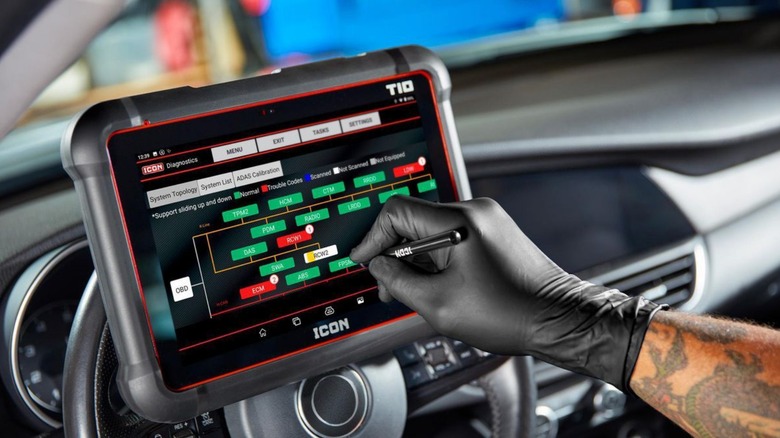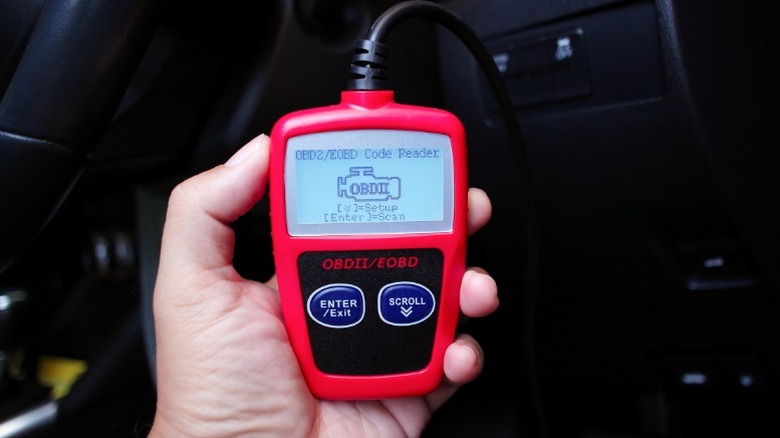Do Cheap Car Diagnostic Tools Work As Well As Pricey Ones?
If you own a car built after 1996, it comes equipped with a second-generation onboard diagnostic (OBD or OBDII) system. These systems work together with the vehicle's primary computer or powertrain control module (PCM) and a vast network of electronics and sensors to monitor vital areas of the car and its critical systems. When the OBDII system detects an error or malfunction, it can trigger a dashboard warning light, like the check engine light, and store a diagnostic trouble code (DTC).
To access the stored DTCs, either to diagnose a problem with your car or turn off the check engine light, you have to use an OBDII scan tool. The most basic code readers allow you to access your vehicle's OBDII system to view and clear active DTCs. However, many advanced scan tools provide far more features, including things like the ability to view live data and graphs, access and clear SRS and ABS codes, as well as do things like perform battery tests and run diagnostic procedures to check individual vehicle systems.
While many professional OBDII scan tools come with extremely expensive prices, you may be surprised to learn that that's not always the case. In fact, there are many affordable scanners on the market that allow you to do basic things like identify and clear check engine light codes. As a former professional mechanic, I've used top of the line scan tools, like those built by Snap-On and Autel, as well as very basic devices, like the relatively cheap tool I own for home and DIY use. If you're wondering whether a cheap diagnostic tool can get the job done just as well as an expensive one, stick around. Here's everything you need to know about cheap versus expensive automotive diagnostic tools.
Cheap diagnostic tools generally work well, but provide fewer features
When it comes to cheap versus expensive car diagnostic tools, the primary differences lie in the devices' capabilities and features. At their core, OBDII code readers are designed to provide access to the OBD system, enabling us to read and clear stored DTCs. Many of the most basic and the cheapest scan tools provide only these functions, while others may offer a few additional features, like helping you determine whether your car will pass an emissions test or the ability to view live data.
Professional-tier scan tools, on the other hand, generally offer far more functions than basic devices. For example, the Harbor Freight Icon T10 diagnostic tool, which is designed to compete with one of Snap-On's most popular scanners, allows you to view and clear DTCs like basic code readers. However, the T10 also comes with advanced features, enabling you to run battery charging and voltage tests, view real-time live data, run system tests, read and clear ABS and SRS fault codes, and more. It also features a built-in borescope camera for deep engine inspections, access to a troubleshooting subscription, and a touchscreen display. Similar features can be found on other high-end scanners, like those built by Snap-On and Autel, and these devices are designed for professionals who earn a living performing auto repairs and maintenance.
In my experience, most code readers work the same, regardless of price. As mentioned, the main differences lie in the capabilities offered by individual devices. However, that's not to say that every dirt-cheap code reader is equally good or practical. It's still important to read product reviews and research a company before investing in its products, even if the product is extremely cheap or seems like a phenomenal deal.
Is a cheap car diagnostic tool right for you?
One of the most important things to think about when shopping for an OBDII code reader is what you plan to do with the tool. If you're an average DIYer and just want a scan tool to keep on hand in case your check engine light appears, you probably don't need the most expensive product on the market. A cheap code reader capable of performing basic tasks like reading and clearing DTCs is probably all that you'll need for sporadic diagnostic work.
On the other hand, if you're a professional home mechanic or hardcore hobbyist, it may be prudent to invest in a costlier code reader. As mentioned, pricier devices frequently offer more features than cheap versions. These features, like the ability to view live data and run specific diagnostic tests, can be invaluable when performing diagnostic work on vehicles you're not familiar with and when performing modifications. They make great additions to your tool kit and can save you time and money when it comes to identifying damage and malfunctions.
Finally, if you're a professional mechanic who works in a shop, you may already have access to a high-dollar scan tool. In my professional experience, repair shops generally supply at least one top-of-the-line code reader. These devices are for shop use, meaning that if you work there and are qualified, you can probably use the shop tool as part of your job. If that's the case, you most likely don't need to invest in an expensive code reader for yourself. Rather, picking up a cheaper device for basic jobs and for tasks you perform outside of work is probably the smartest move, and diagnostic tools are actually one of the primary areas in which you should skimp when building a mechanic's tool kit.


